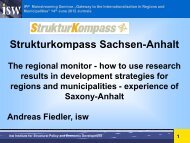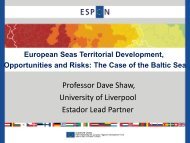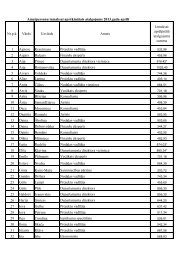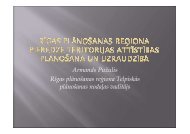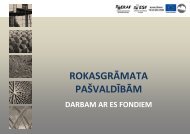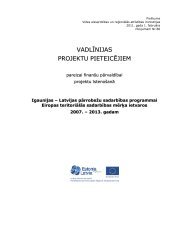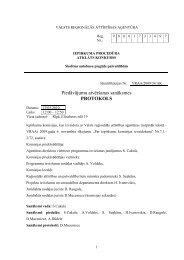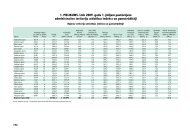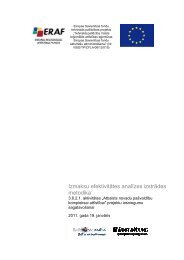Benchmark Study 1
Benchmark Study 1
Benchmark Study 1
Create successful ePaper yourself
Turn your PDF publications into a flip-book with our unique Google optimized e-Paper software.
IPP 1st BENCHMARK REPORT<br />
Key sector advantages:<br />
o availability of vast domestic and imported wood resources<br />
o skilled labour force in a historically traditional industry<br />
o established timber-processing sector including proven R&D capability<br />
In Latvia, the wood processing sector is the largest manufacturing sector in added value. It has been<br />
experiencing very high growth in added value although it has declined in employment, with a large gain<br />
in productivity. However, the crisis in 2008 has hit the sector strongly and it experienced a 26.3%<br />
decline in value added, mainly in wood and wood products and in furniture.<br />
Besides being the most specialized in the sector of all European Union countries, Latvia is in the top<br />
countries in terms of investment rates and labour competitiveness in all subsectors which has enabled it<br />
to grow consistently. In terms of subsectors, Latvia is heavily specialized in wood and wood products<br />
and among them in the least processed products: sawn wood. The subsectors and product types with<br />
the largest growth have been builders’ carpentry, wooden containers, other wood products and<br />
printing.<br />
In addition, Latvia is well developed in wood energy and has enough raw material from the sawmills to<br />
grow strongly in this subsector. The wood energy subsector is very developed in Latvia. Despite being a<br />
relative small country, it is the 7th country in European Union in terms of pellets production capacity,<br />
even though there is little local demand for it. Unlike pellets, wood biomass is widely used for energy,<br />
especially for heating purposes, and it is the main source of renewable energy in Latvia.<br />
Textile<br />
Today, the textile sector is an important part of Latvian industry and combines the best of traditional<br />
knowhow with industrial and technological knowledge. This expertise has lead to the creation of high<br />
value-added products such as silver and amber threads and other innovative technologies. The<br />
industry is highly export-oriented, particularly the lingerie segment.<br />
The main textile industry sub-sectors are lingerie manufacturing, sewing, weaving, technical textile<br />
manufacturing and artisan textile production. The industry is dominated by sewing companies<br />
acting as outsourced production for EU brands. This is convenient as production and delivery times are<br />
short and technical capabilities are advanced – starting from embroidery, ending with laser cutting and<br />
waterproof-garment production. These sewing companies provide customized services, including<br />
pattern and other design services. However, there are also a number of local small and medium<br />
companies who are working on their own jersey, knitwear and other material collections, bringing<br />
forward the idea of natural and ecological clothing.<br />
While home textiles from linen, such as tablecloths and curtains are very popular among the local<br />
population, the most exclusive linen items such as accessories and shawls are being highly appreciated<br />
Page 62<br />
www.i-p-p.eu



